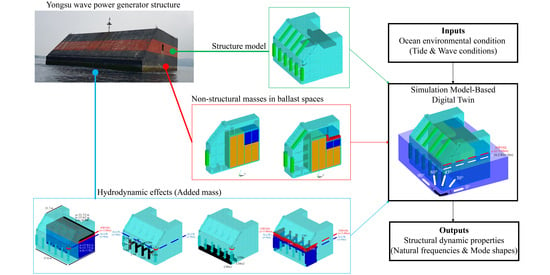Development of a Simulation Model for Digital Twin of an Oscillating Water Column Wave Power Generator Structure with Ocean Environmental Effect
Abstract
:1. Introduction
1.1. Structural Issue under Uncertainty of Wave Power Generator
1.2. Digital Twin System of General Structures
1.3. Challenges and Cause Analysis in Developing a Digital Twin of Offshore Structures
1.4. Contribution and Flowchart in Developing the Digital Twin Baseline Model
2. Materials and Methods
2.1. Specification of the OWC Generator Structure
2.2. Structure
2.3. Ballasts
2.4. Hydrodynamic Effects
2.4.1. Approach
2.4.2. Site Condition
2.4.3. Modeling of Added Mass Effect
3. Results and Discussion
4. Conclusions
Author Contributions
Funding
Institutional Review Board Statement
Informed Consent Statement
Data Availability Statement
Conflicts of Interest
References
- Lupago. Available online: https://blog.naver.com/qrlab/221298632729 (accessed on 3 October 2023).
- Seo, D.; Huh, T.; Kim, M.; Hwang, J.; Jung, D. Prediction of Air Pressure Change Inside the Chamber of an Oscillating Water Column-Wave Energy Converter Using Machine-Learning in Big Data Platform. Energies 2021, 14, 2982. [Google Scholar] [CrossRef]
- Kim, T.-W.; Oh, J.; Min, C.; Hwang, S.-Y.; Kim, M.-S.; Lee, J.-H. An Experimental Study on Condition Diagnosis for Thrust Bearings in Oscillating Water Column Type Wave Power Systems. Sensors 2021, 21, 457. [Google Scholar] [CrossRef] [PubMed]
- Kim, B.; Min, C.; Kim, H.; Cho, S.; Oh, J.; Ha, S.-H.; Yi, J.-H. Structural Health Monitoring with Sensor Data and Cosine Similarity for Multi-Damages. Sensors 2019, 19, 3047. [Google Scholar] [CrossRef] [PubMed]
- Kim, B.; Oh, J.; Min, C. Investigation on applicability and limitation of cosine similarity-based structural condition monitoring for Gageocho offshore structure. Sensors 2022, 22, 663. [Google Scholar] [CrossRef]
- Lee, J.W. Service Report on Structural Safety Review for Air Pressure Change in Offshore Transformation Facility Chamber at Jeju Wave Test Site; KRISO: Daejeon, Republic of Korea, 2021. (In Korean) [Google Scholar]
- Vivim, Q.L.; Parlikad, A.K.; Woodall, P.; Ranasinghe, G.D.; Heaton, J. Developing a Dynamic Digital Twin at a Building Level: Using Cambridge Campus as Case Study. In Proceedings of the International Conference on Smart Infrastructure and Construction 2019 (ICSIC), Cambridge Centre for Smart Infrastructure & Construction, Cambridge, UK, 8–10 July 2019; ICE Publishing: Leeds, UK; pp. 67–75.
- Park, K.T.; Nam, Y.W.; Lee, H.S.; Im, S.J.; Noh, S.D.; Son, J.Y.; Kim, H. Design and implementation of a digital twin application for a connected micro smart factory. Int. J. Comput. Integr. Manuf. 2019, 32, 596–614. [Google Scholar] [CrossRef]
- Deng, T.; Zhang, J.; Shen, Z.-J.M. A systematic review of a digital twin city: A new pattern of urban governance toward smart cities. J. Manag. Sci. Eng. 2021, 6, 125–134. [Google Scholar] [CrossRef]
- Tao, F.; Zhang, H.; Liu, A.; Nee, A.Y.C. Digital Twin in Industry: State-of-the-Art. IEEE Trans. Ind. Inform. 2019, 15, 2405–2415. [Google Scholar] [CrossRef]
- Errandonea, I.; Beltrán, S.; Arrizabalaga, S. Digital Twin for maintenance: A literature review. Comput. Ind. 2020, 123, 103316. [Google Scholar] [CrossRef]
- Shim, C.-S.; Dang, N.-S.; Lon, S.; Jeon, C.-H. Development of a bridge maintenance system for prestressed concrete bridges using 3D digital twin model. Struct. Infrastruct. Eng. 2019, 15, 1319–1332. [Google Scholar] [CrossRef]
- Kang, J.-S.; Chung, K.; Jong, E.J. Multimedia knowledge-based bridge health monitoring using digital twin. Multimed. Tools Appl. 2021, 80, 34609–34624. [Google Scholar] [CrossRef]
- Yi, J.-H.; Kim, B.; Min, I.-K.; Shim, J.S. Long-term vibration monitoring and model updating of Gageocho ocean research station. In Proceedings of the 5th International Conference on Smart Monitoring, Assessment and Rehabilitation of Civil Structures (SMAR 2019), Potsdam, Germany, 29 August 2019. [Google Scholar]
- Kim, B.; Yi, J.-H. Structural model updating of the Gageocho Ocean Research Station using mass reallocation method. Smart Struct. Syst. 2019, 26, 291–309. [Google Scholar]
- Yi, J.-H.; Park, W.-S.; Lee, S.-Y.; Kim, J.-T.; Seo, C.-G. Evaluation of vibration characteristics of caisson-type breakwater using impact vibration tests and validation of numerical analysis model. J. Korean Soc. Coast. Ocean Eng. 2013, 25, 1–10. (In Korean) [Google Scholar] [CrossRef]
- Teughels, A.; Roeck, G.D. Structural damage identification of the highway bridge Z24 by FE model updating. J. Sound Vib. 2004, 278, 589–610. [Google Scholar] [CrossRef]
- Deng, L.; Cai, C.S. Development of dynamic impact factor for performance evaluation of existing multi-girder concrete bridges. Eng. Struct. 2010, 32, 21–31. [Google Scholar] [CrossRef]
- Foti, D.; Chorro, S.I.; Sabbà, M.F. Dynamic investigation of an ancient masonry bell tower with operational modal análisis. Open Constr. Build. Technol. J. 2012, 6, 384–391. [Google Scholar] [CrossRef]
- Han, J.; Luo, Y. Static and dynamic finite element model updating of a rigid frame-continuous girders bridge based on response surface method. Adv. Mater. Res. 2013, 639–640, 992–997. [Google Scholar] [CrossRef]
- ANSYS, Inc. ANSYS Mechanical APDL User Guide, Release 18.1; ANSYS, Inc.: Canonsburg, PA, USA, 2018. [Google Scholar]
- Das, B.M. Advanced Soil Mechanics, 3rd ed.; Taylor & Francis: New York, NY, USA, 2008; pp. 479–483. [Google Scholar]
- Bowles, J.E. Foundation Analysis and Design, 5th ed.; McGraw-Hill Companies: Singapore, 1996; pp. 123–125. [Google Scholar]
- Bayraktar, A.; Sevim, B.; Altunişik, A.C. Finite element model updating effects on nonlinear seismic response of arch dam–reservoir–foundation systems. Finite Elem. Anal. Des. 2011, 47, 85–97. [Google Scholar] [CrossRef]
- Det Norske Varitas. Environmental Conditions and Environmental Loads (Recommendation Practice C205); Det Norske Varitas: Oslo, Norway, 2010. [Google Scholar]
- Greenhow, M.; Yanbao, L. Added masses for circular cylinders near or penetrating fluid boundaries—Review, extension and application to water-entry,-exit and slamming. Ocean Eng. 1987, 14, 325–348. [Google Scholar] [CrossRef]
- Greenhow, M.; Ahn, S.I. Added mass and damping o horizontal circular cylinder sections. Ocean Eng. 1988, 15, 495–504. [Google Scholar] [CrossRef]
- McCamy, R.; Fuchs, R. Wave Forces on Piles: Diffraction Theory; U.S. Army Corps of Engineers Beach Erosion Board Technical Memo Number 44; U.S. Army Corps of Engineers: Washington, DC, USA, 1954.
- Rahman, M.; Bhatta, D.D. Evaluation of added mass and damping coefficient of an oscillating circular cylinder. Appl. Math. Model. 1993, 17, 70–79. [Google Scholar] [CrossRef]
- Yang, C.; Liang, K.; Zhang, X.; Geng, X. Sensor placement algorithm for structural health monitoring with redundancy elimination model based on sub-clustering strategy. Mech. Syst. Signal Process. 2019, 124, 369–387. [Google Scholar] [CrossRef]
- Yang, C.; Xia, Y. Interval Pareto front-based multi-objective robust optimization for sensor placement in structural modal identification. Reliab. Eng. Syst. Saf. 2023, 242, 109703. [Google Scholar] [CrossRef]

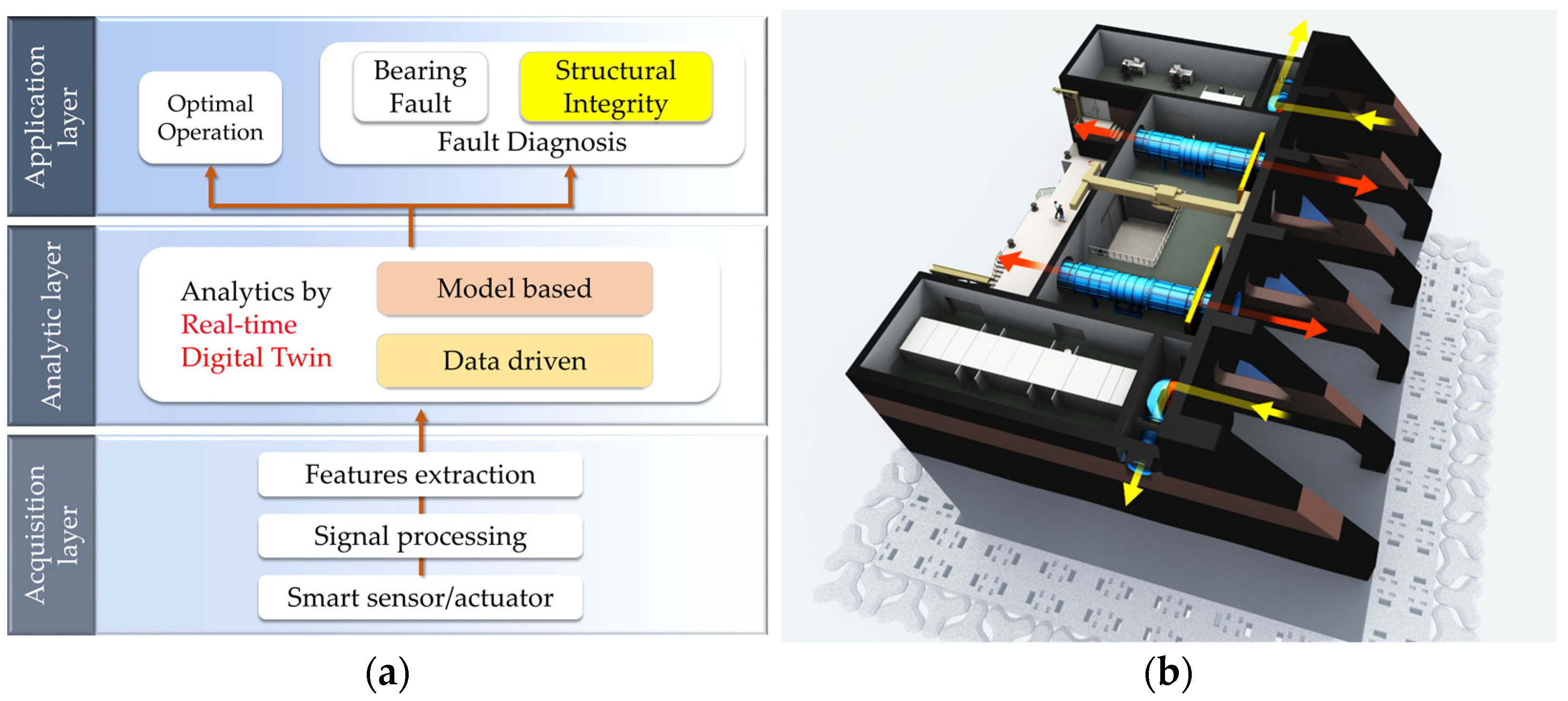

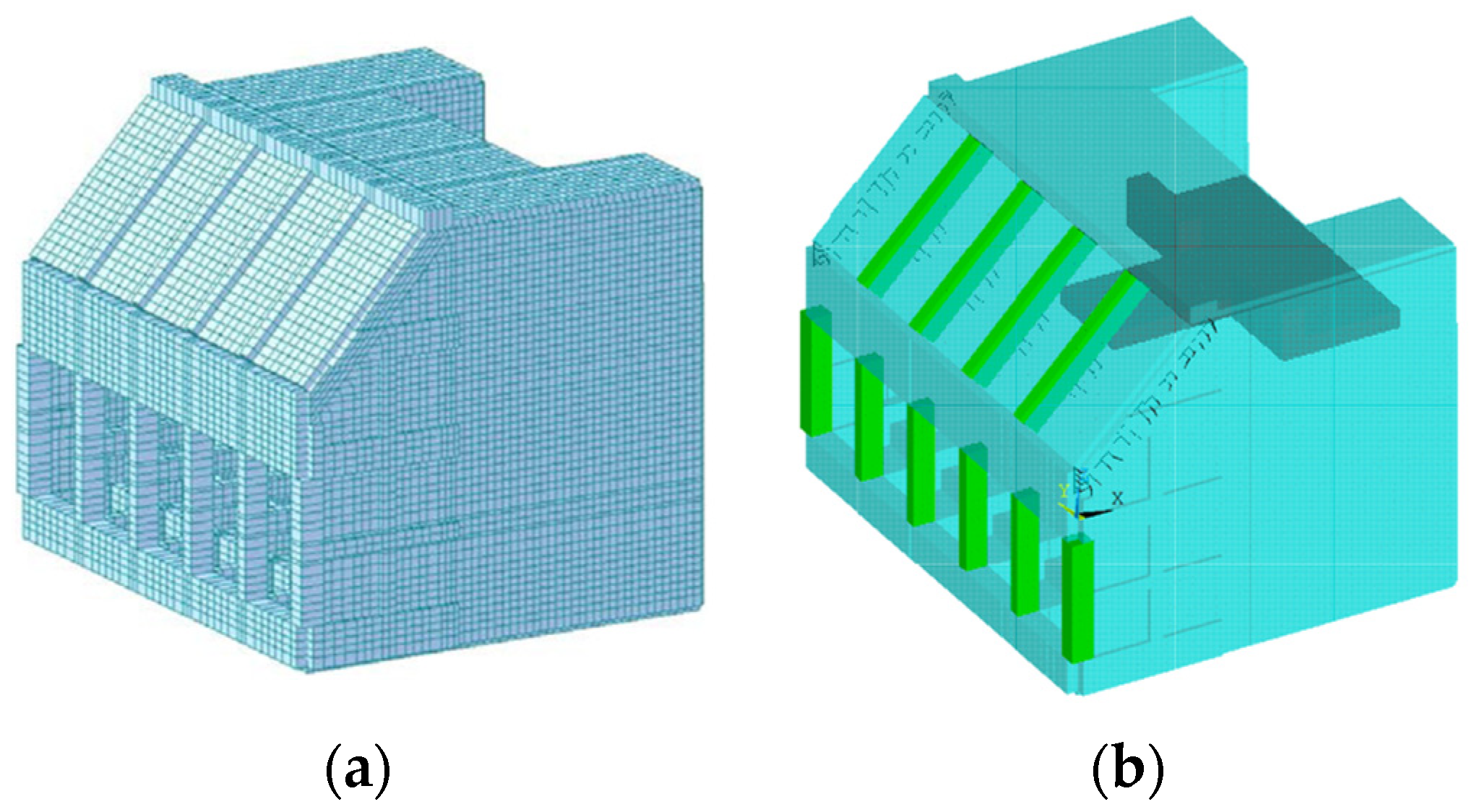
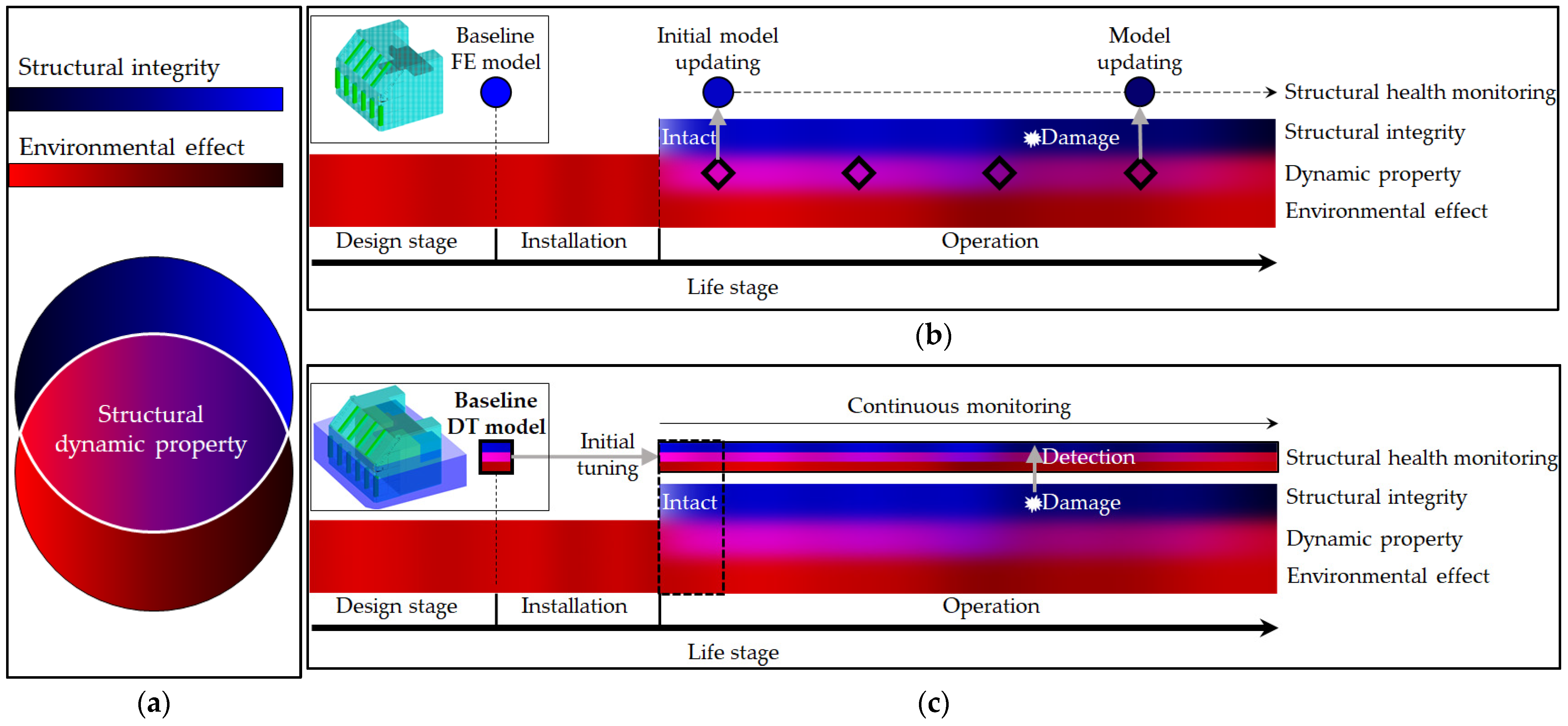
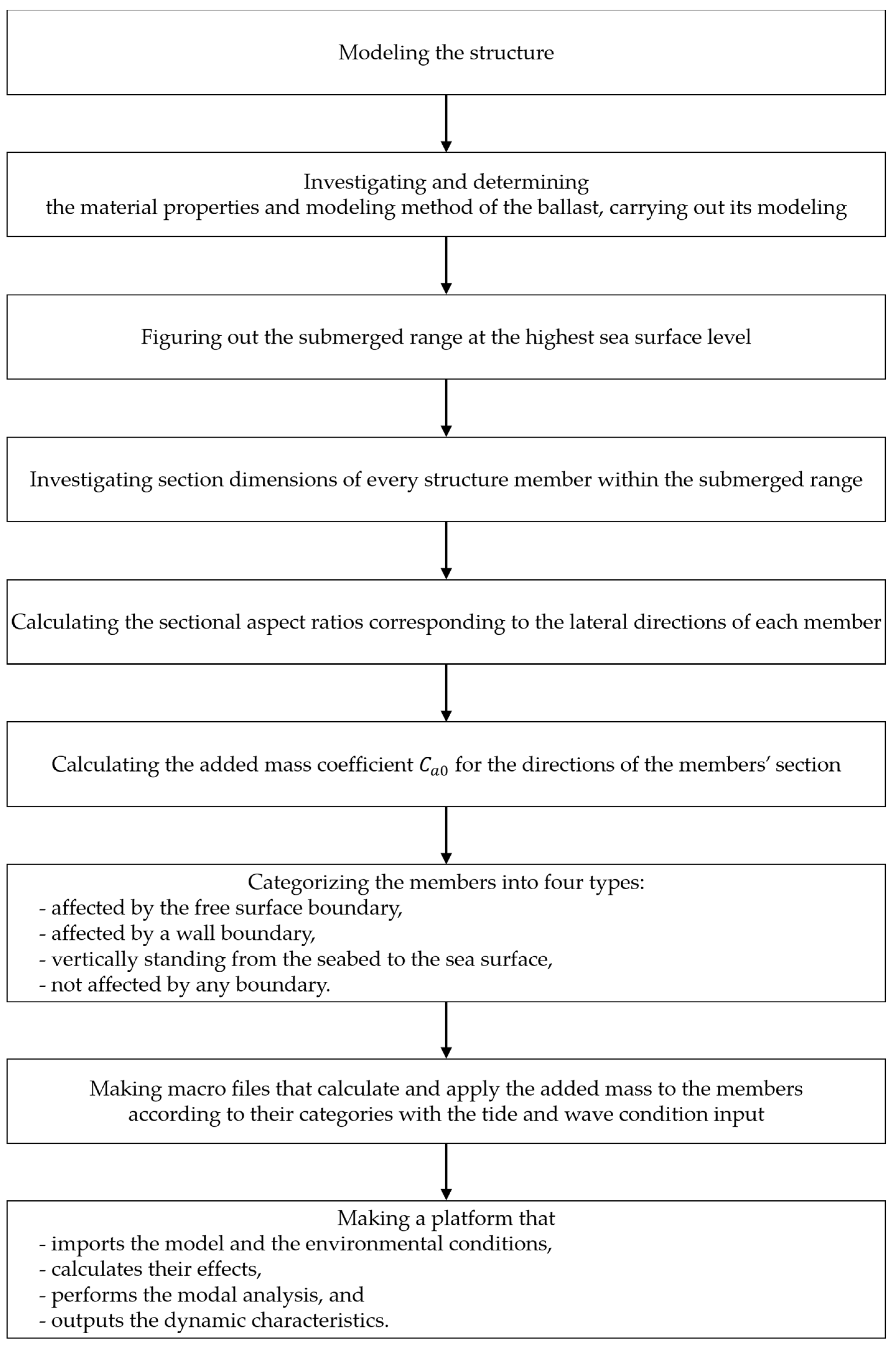
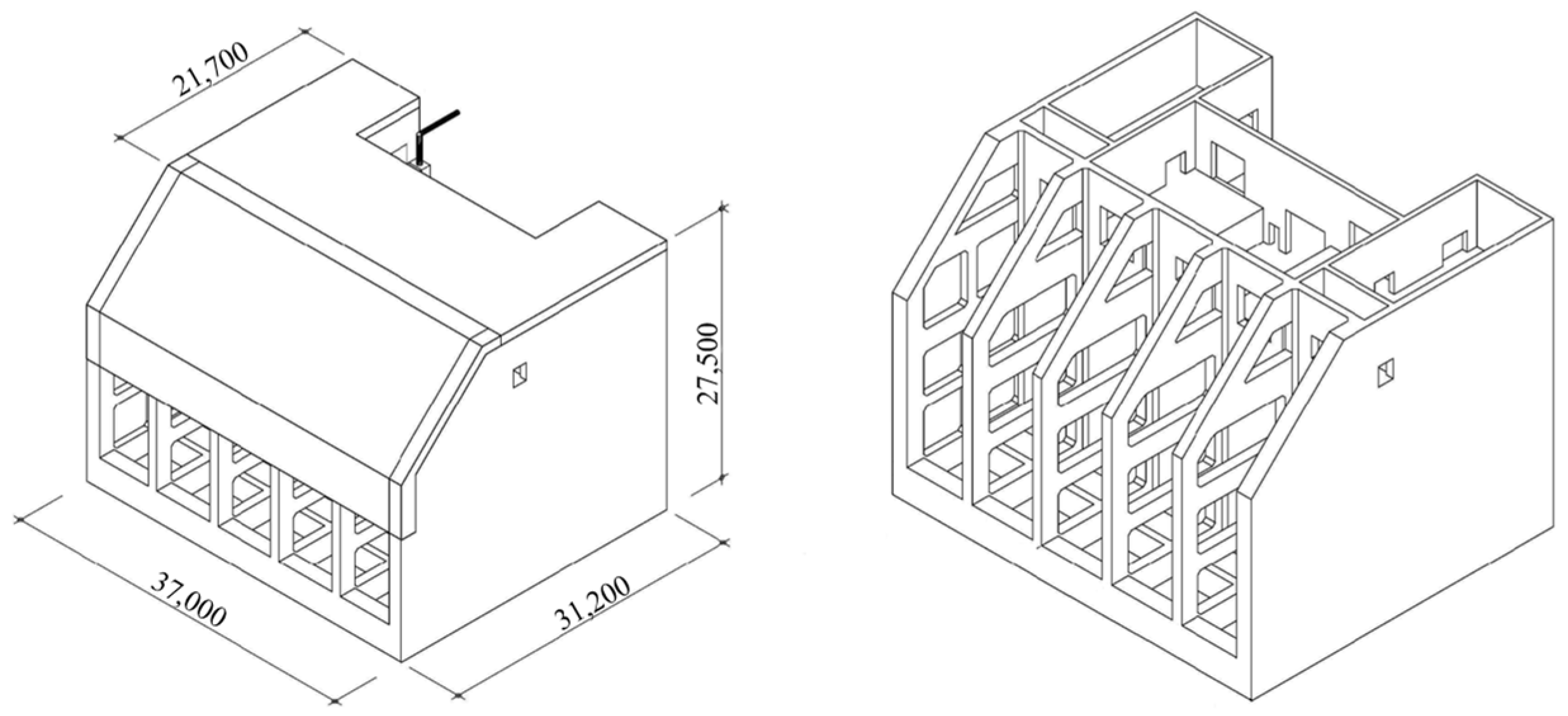

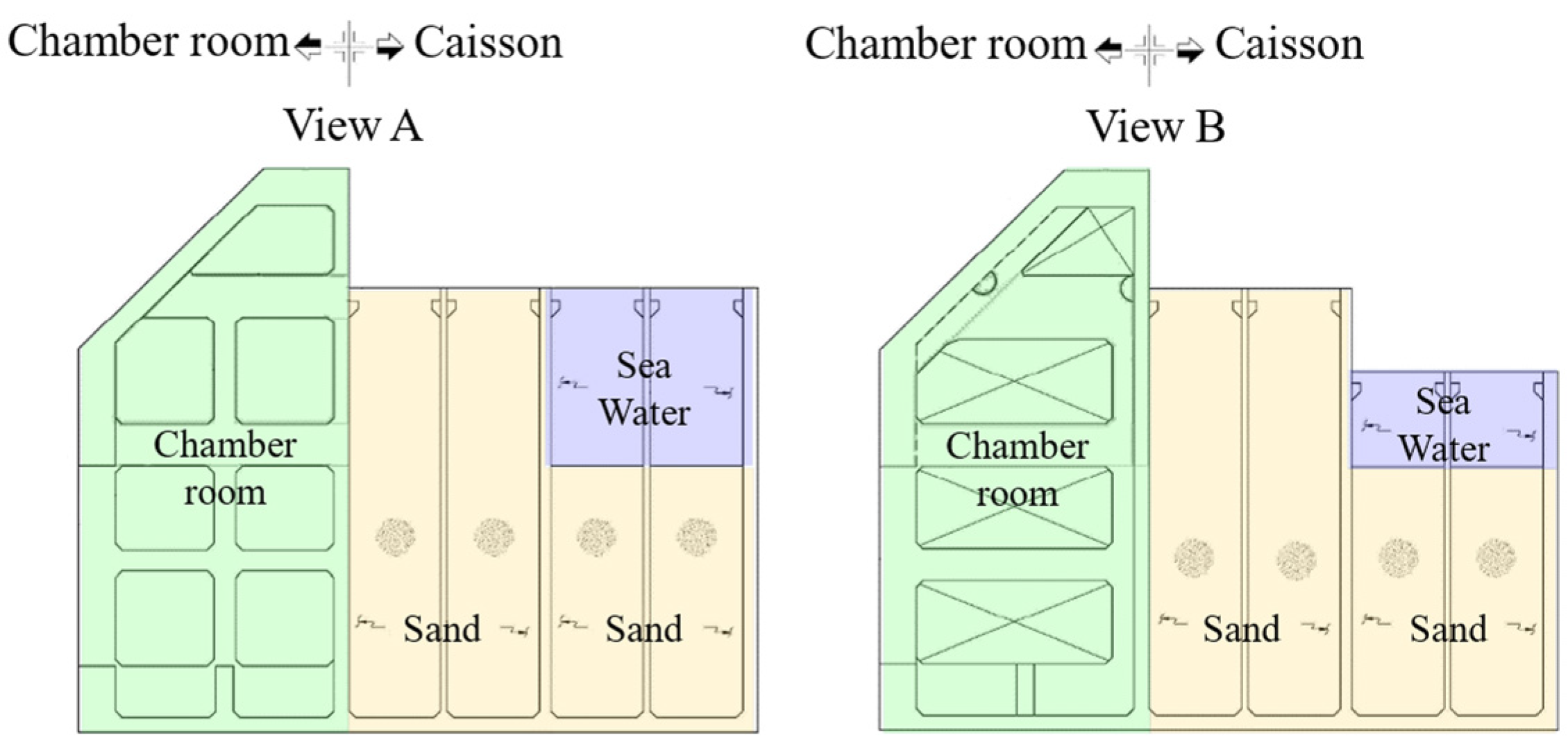
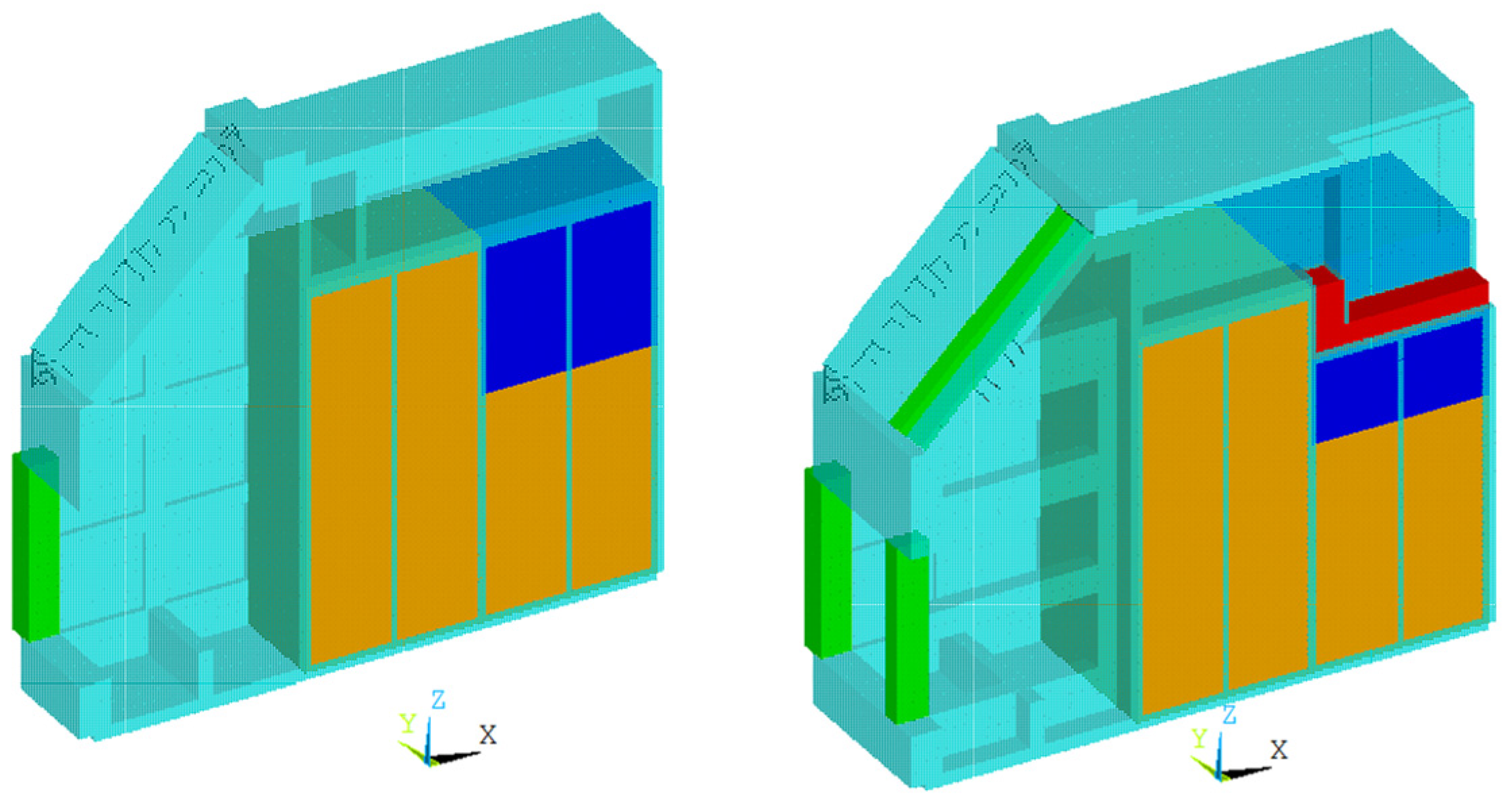

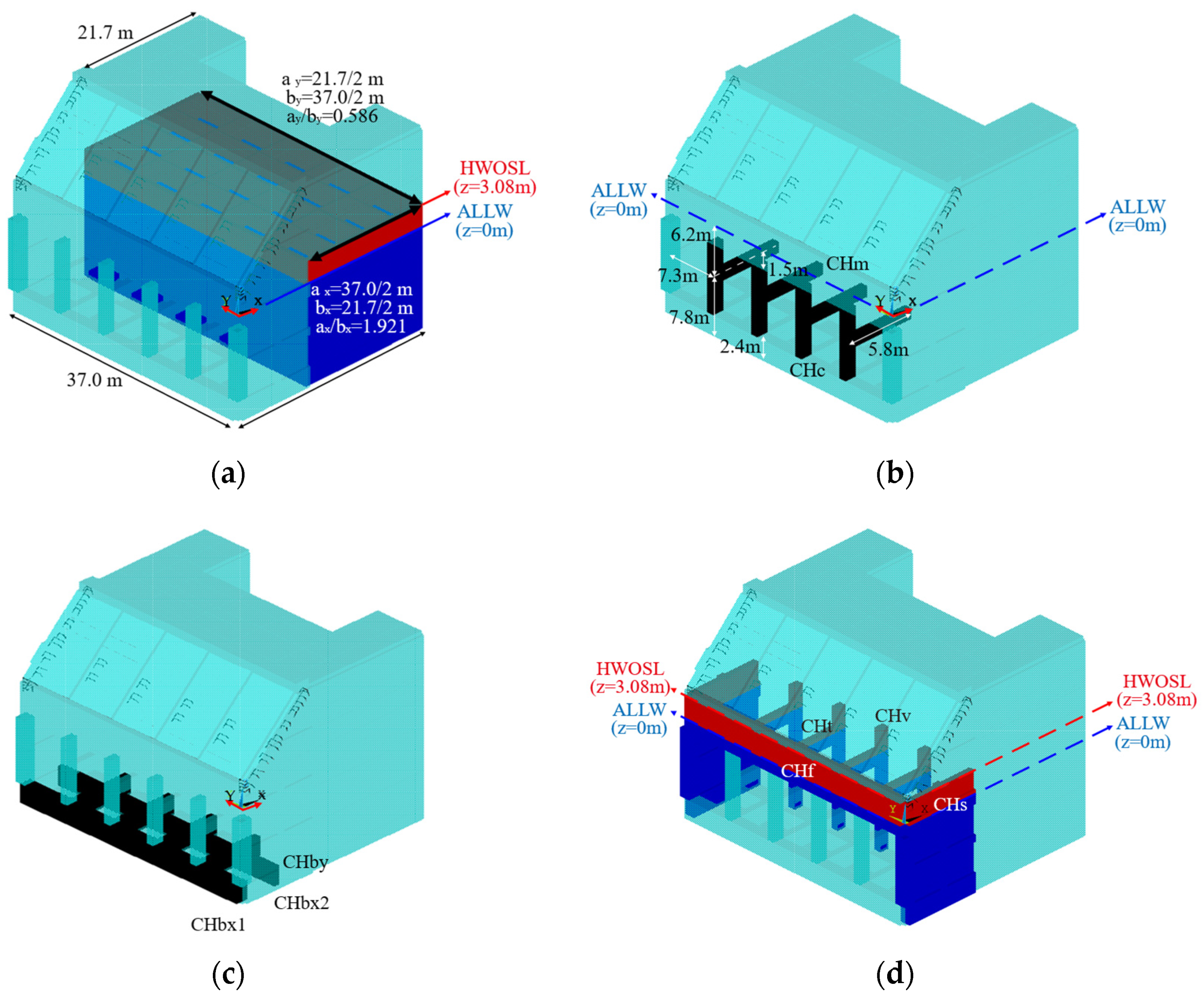


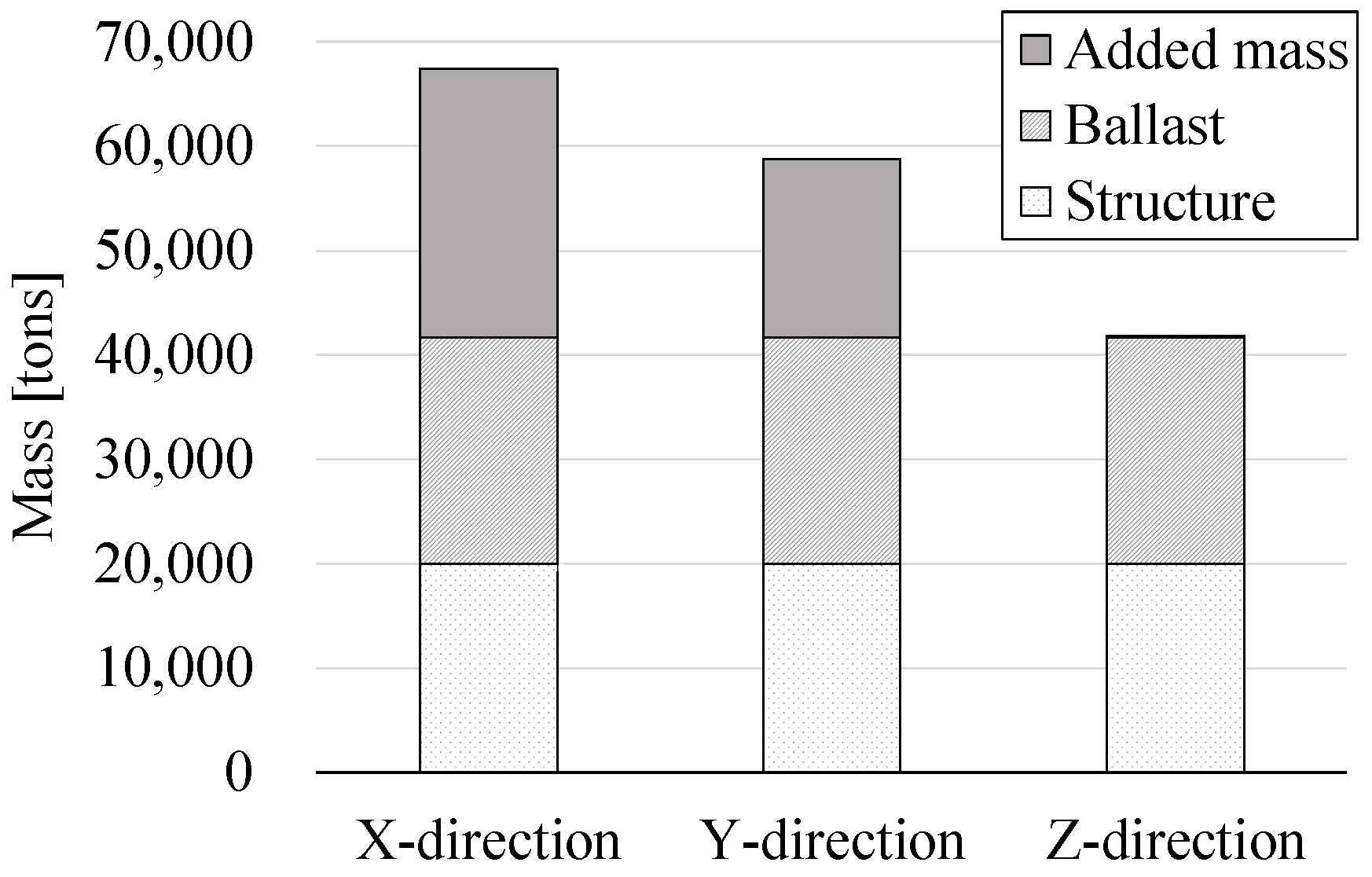
| Type | Cause | Aspect | Reason | Alternative Solution |
|---|---|---|---|---|
| General structure | Simplification | Model | For conservative and convenient modeling, 1D/2D element types are used to model a real structure in general, and minor structural members are often ignored. | - |
| Non-structural mass omission | Model | For a conservative safety evaluation, mass components, such as appurtenance, equipment, and facilities, are usually regarded as the weight or density increase. | Mass modeling and Initial tuning | |
| Boundary condition | Model | The boundary condition is frequently simplified to the six degrees of freedom. | Advanced modeling and Initial tuning | |
| Reality | Civil foundations, such as piling and grouting, are affected by the uncertainty of geotechnical property and interaction. | |||
| Material uncertainty | Reality | Concrete materials entirely depend on the curing completeness. | Initial tuning | |
| Construction error | Reality | Sizes and spacings of rebars in reinforcement concrete have uncertainty in the construction process. | - | |
| Offshore structure | Biofouling | Model | For a conservative safety evaluation, the thickest biofouling is considered as well as frequently modeled as the weight load instead of its volume having mass. | Parametric modeling |
| Reality | The thickness, range, density, and roughness of the biofouling are not clearly figured out in reality because they vary over time. | Varying over time | ||
| Corrosion | Model | For a conservative safety evaluation, in general, the maximum corroded member sections are assumed and modeled. | Parametric modeling | |
| Reality | The degree and range of the corrosion are difficult to clarify in reality. | Varying over time | ||
| Hydrodynamic effects | Model | For a conservative safety evaluation, the hydrodynamic effects are usually regarded as the forces, not as the mass. | Parametric modeling | |
| Reality | The degree of the hydrodynamic effects, such as the added mass or fluid damping effect, relies on the environmental conditions. | Varying over time |
| Density | Elastic Modulus | Poisson Ratio |
|---|---|---|
| 2400 kg/m3 | 29.8 × 103 MPa | 0.18 |
| Reference | Type of Sand | Elastic Modulus (MPa) | Poisson Ratio |
|---|---|---|---|
| Das [22] | Loose | 10.35–24.15 | 0.20–0.40 |
| Medium dense | 17.25–27.60 | 0.25–0.40 | |
| Dense | 34.50–55.20 | 0.30–0.45 | |
| Silty | 10.35–17.25 | 0.20–0.40 | |
| Sand with gravel | 69.00–172.50 | 0.15–0.35 | |
| Bowles [23] | Loose | 10–25 | 0.3–0.4 (commonly used) |
| Dense | 50–81 | ||
| Silty | 5–20 | ||
| Sand with gravel | 50–200 |
| Material | Density | Elastic Modulus | Poisson Ratio |
|---|---|---|---|
| Sand | 1835 kg/m3 | 10.0 MPa | 0.30 |
| Water | 1024 kg/m3 | 2.07 × 103 MPa | 0.49 |
| Member | Section (m) | Direction | a (m) | b (m) | Aspect Ratio | |||
|---|---|---|---|---|---|---|---|---|
| Width | Length | (a/b) | ||||||
| Caisson | 37.0 | 21.7 | X | 18.50 | 10.85 | 1.92 | 1.404 | * |
| Y | 10.85 | 18.50 | 0.57 | 1.667 | * | |||
| Member | Section (m) | Direction | a (m) | b (m) | Aspect Ratio | |||
|---|---|---|---|---|---|---|---|---|
| Width | Length | (a/b) | ||||||
| CHm | 1.00 | 1.50 | Y | 0.75 | 0.50 | 1.50 | 1.435 | 9.73 |
| Z | 0.50 | 0.75 | 0.67 | 1.637 | 12.4 | |||
| CHc | 1.00 | 1.70 | Y | 0.85 | 0.50 | 1.70 | 1.405 | 8.59 |
| X | 0.50 | 0.85 | 0.59 | 1.666 | 11.6 | |||
| Member | Section (m) | Direction | a (m) | b (m) | Aspect Ratio | |||
|---|---|---|---|---|---|---|---|---|
| Width | Length | (a/b) | ||||||
| CHbx1 | 1.70 | 2.40 | X | 1.20 | 0.85 | 1.50 | 1.448 | 3.316 |
| CHbx2 | 0.80 | 2.40 | X | 1.20 | 0.40 | 3.00 | 1.310 | 3.000 |
| CHby | 1.00 | 2.40 | Y | 1.20 | 0.50 | 2.40 | 1.340 | 3.068 |
| Member | Section (m) | Direction | a (m) | b (m) | Aspect Ratio | |||
|---|---|---|---|---|---|---|---|---|
| Width | Length | (a/b) | ||||||
| CHt | 1.00 | 2.00 | Y | 1.00 | 0.50 | 2.00 | 1.36 | * |
| Z | 0.50 | 1.00 | 0.50 | 1.70 | * | |||
| CHv | 1.00 | 1.35 | Y | 0.68 | 0.50 | 1.36 | 1.46 | 1 |
| CHf | 1.70 | 1.50 + | X | 1.50 + | 1.70 | * | * | 1 |
| CHs | 1.04 | 1.15 | Y | 5.58 | 0.52 | 10.73 | 1 | - |
| Component | Model R | Model 1 |
|---|---|---|
| Structure | 19,975 | 19,975 |
| Ballast | - | 21,698 |
| Total | 19,975 | 41,673 |
| Depth | Tide | Wave | |||
|---|---|---|---|---|---|
| Direction | Height | Period | Length | ||
| ALLW | HWOSL | 0° | 8.2 m | 12.9 s | 161.06 m |
| Model R | Model 1 | Model 2 |
|---|---|---|
| 7.537 Hz | 5.976 Hz | 5.514 Hz |
| 3.08 m (HWOSL) | 2 m | 1 m | 0 m (ALLW) |
|---|---|---|---|
| 5.514 Hz | 5.574 Hz | 5.664 Hz | 5.739 Hz |
| 0° | 30° | 45° | 60° | 90° |
|---|---|---|---|---|
| 5.514 Hz | 5.530 Hz | 5.539 Hz | 5.547 Hz | 5.554 Hz |
| Environmental Change | Tide | Wave Direction | Total |
|---|---|---|---|
| Max (A) | 5.739 Hz | 5.554 Hz | - |
| Min (B) | 5.514 Hz | 5.514 Hz | - |
| Difference (C = A − B) | 0.225 Hz | 0.040 Hz | - |
| % (100 × C/B) | 4.08 | 0.73 | 4.81 |
Disclaimer/Publisher’s Note: The statements, opinions and data contained in all publications are solely those of the individual author(s) and contributor(s) and not of MDPI and/or the editor(s). MDPI and/or the editor(s) disclaim responsibility for any injury to people or property resulting from any ideas, methods, instructions or products referred to in the content. |
© 2023 by the authors. Licensee MDPI, Basel, Switzerland. This article is an open access article distributed under the terms and conditions of the Creative Commons Attribution (CC BY) license (https://creativecommons.org/licenses/by/4.0/).
Share and Cite
Kim, B.; Oh, J.; Min, C. Development of a Simulation Model for Digital Twin of an Oscillating Water Column Wave Power Generator Structure with Ocean Environmental Effect. Sensors 2023, 23, 9472. https://doi.org/10.3390/s23239472
Kim B, Oh J, Min C. Development of a Simulation Model for Digital Twin of an Oscillating Water Column Wave Power Generator Structure with Ocean Environmental Effect. Sensors. 2023; 23(23):9472. https://doi.org/10.3390/s23239472
Chicago/Turabian StyleKim, Byungmo, Jaewon Oh, and Cheonhong Min. 2023. "Development of a Simulation Model for Digital Twin of an Oscillating Water Column Wave Power Generator Structure with Ocean Environmental Effect" Sensors 23, no. 23: 9472. https://doi.org/10.3390/s23239472
APA StyleKim, B., Oh, J., & Min, C. (2023). Development of a Simulation Model for Digital Twin of an Oscillating Water Column Wave Power Generator Structure with Ocean Environmental Effect. Sensors, 23(23), 9472. https://doi.org/10.3390/s23239472








